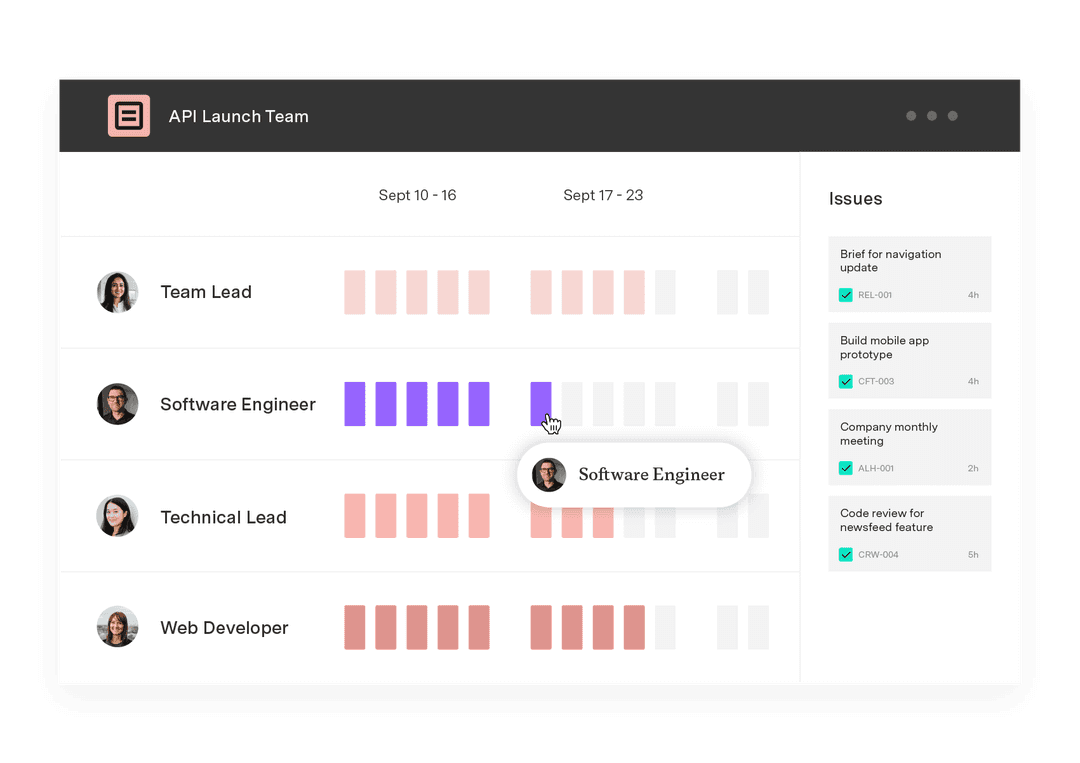3 project charter templates for clarity and alignment
Tempo Team
Project charters provide a high-level overview that connects teammates and external stakeholders. They authorize a project and establish need-to-know elements like scope, deliverables, and responsibilities, serving as a helpful reference throughout the project’s lifecycle.
Project charter templates cover the essentials for you, and there are unique outlines for every type of project, so you can launch initiatives faster without sacrificing precision and clarity.
In this guide, we’ll share three project charter templates and the key components that go into them to help you elevate your process from the start.
What’s a project charter template?
A project charter authorizes a project and outlines key components, including the initiative’s purpose, objectives, and scope. It defines key information for all stakeholders and acts as a quick reference for teams throughout the process. This project documentation sits between the initial proposal and a full, exhaustive plan – charters formally authorize a project after the proposal, and lay the groundwork for a detailed roadmap.
Project charter templates offer a pre-structured framework, so all you need to do is fill in the blanks. For instance, a project charter example template would have fields for key stakeholders, outlining their roles and communication preferences.
Why is a project charter template important?
Project charter templates help you secure essential information quickly. While it’s vital to define elements like project budget, roles, and responsibilities, it takes a lot of time and effort, and a thorough framework does the heavy lifting during a hectic time.
Templates ensure you never lose or muddle important details, which is especially crucial during fast-paced projects or manager knowledge transfers. A well-filled-out template clarifies expectations, creates a single source of truth, and answers questions, improving stakeholder management and alignment.
These templates don’t just reduce the risk of failed projects, they nail down the core components of an initiative to strengthen your direction, helping you continuously build your project management skills.
How to write a project charter: 8 elements
While every document is different depending on your purpose and objectives, they all follow a similar structure. Here are the most common project charter components.
1. Project objectives
Define the project’s goals, including the deliverables and the intangible metrics you hope to achieve. While you’ll cover the deliverables in a separate section, it’s still best to include them in the objectives for transparency.
Choose specific, measurable goals to set clear expectations, and keep them realistic to encourage consistently successful projects. For example, a development project may have the objective, “Release the new software by the end of the fiscal year.”
2. Scope and deliverables
Detail everything that’s included in the project, including tasks, project milestones, and deliverables. This establishes your project’s limits, letting you allocate accurate resources and monitor scope creep.
Some charters also cover out-of-scope activities. This is important if certain tasks are typically associated with a project – you need to establish the boundaries from the start. For instance, a website creation project may specify, “DevPlus isn’t responsible for ongoing website maintenance.”
3. Key stakeholders
List people who have an interest in the project, such as executives, customers, and sponsors. This helps you define and meet success criteria for each party, and keeps track of essential details like their role and contact information.
Including key stakeholders also lets you build a tailored communication plan in advance, so teammates know who to contact and how when delivering updates.
4. High-level budget and resources
Add an initial project budget estimate, including resource costs and possible budget constraints. For example, a software development project should account for labor, software, and hardware spend, as well as overhead and post-deployment costs.
Include each team member and their total effort in the project. You’ll detail their responsibilities later on, but it’s a good idea to estimate their impact on the budget here.
5. High-level risks and constraints
Write an overview of project risks and constraints. This list won’t be exhaustive – summarize the most significant, anticipated threats to a project’s success. Add the likelihood, impact, and the risk management plan you have to address it.
Keep this brief – your risk register will have all the details, including a risk matrix and comprehensive response strategies.
6. Project milestones and timeline
Summarize your projected timeline and schedule, like predicted milestones and due dates. This won’t be exact, but it helps set expectations and forms a solid foundation for detailed project planning. Templates typically also include a section for the actual completion dates, so teams can update charters after a project’s end for historical reference.
7. Success criteria
These are the standards that determine a successful project. Use measurable metrics for a firm benchmark to compare against performance and progress. This also guides decisions – for instance, teams may have to make trade-offs from the initial plans to meet the established success criteria.
Say a content creation team defines a success criterion as “Deliver 10 high-quality videos per month.” If it looks like they won’t meet their goal of 10 videos, they may outsource one video to meet the criteria before the end of the month.
8. Roles and responsibilities
Add the project team, including the project manager and team members. Smaller projects should list every teammate, but large initiatives usually only include key roles.
Detail this information in a table with columns for names, roles, and responsibilities. While some charters also include skills and job descriptions, it’s typically best to keep your table succinct and simply provide a link to a detailed team list.
3 project charter templates
Here are a few flexible project charter templates to jump-start your next initiative.
1. The simple one-page project charter
This charter is designed to launch projects quickly. Here are the elements to include:
Project name and manager: List the project name, manager, and sponsor. Add a simple cost and completion estimation – nothing detailed, just a few key numbers is fine.
Overview: Here, list the purpose, deliverables, and success criteria.
Scope: Summarize the scope in a paragraph, adding what’s out of scope directly beneath it.
Schedule: Include a table with key milestones and their estimated start and end dates.
2. The detailed formal project charter template
This builds off the one-page template, allowing you to expand on costs and define stakeholders and risks. Here’s the basic layout:
All information from the one-page charter: Start with the elements in the above charter – this is the first page of this two-page template.
Resources: List the project team and their roles. Add supporting resources, like additional departments and necessary software.
Costs: Include the estimated costs of labor, supplies, and software. If applicable, add per-hour rates and quantities.
Stakeholders: Define important stakeholders and customers. Summarize the expected benefits to stakeholders to clarify purpose and value.
Risks and constraints: Describe your project’s primary risks and constraints. Include a link to your risk register for full transparency.
3. The agile project charter template
Agile project charters are less detailed and more flexible, relying on continuous updates and involvement to engage and align stakeholders. While agile project charters should be updated to reflect evolving needs, here are the elements to define at the start:
General project details: List the project manager, sponsor, and champion, as well as the project name and stakeholders. This quick table will also include your anticipated start and end dates.
Deeper project information: Write an informative yet concise project summary describing purpose and scope. Add a separate section to list objectives and success criteria.
Bring your project to life with Tempo
Project charters are an important step for a well-planned, successful project, offering an essential high-level overview and a solid point of reference – but they’re just the beginning. You can move from a rough draft to a polished plan with Tempo. For example, Capacity Planner helps you automatically assign resources based on availability and skills, so you can choose the best fit without risk of burnout and overbooking.
You can also inform your budget estimates with Financial Manager. Examine spending patterns throughout your portfolio, accurately predict costs, and monitor your project spend throughout its lifecycle.
Elevate your plans, enhance alignment, and see better outcomes with Tempo.












































